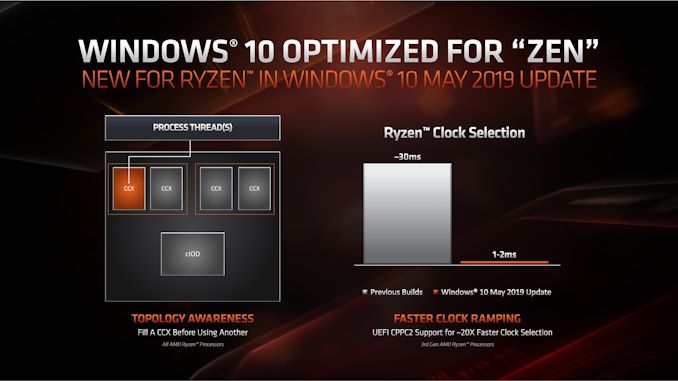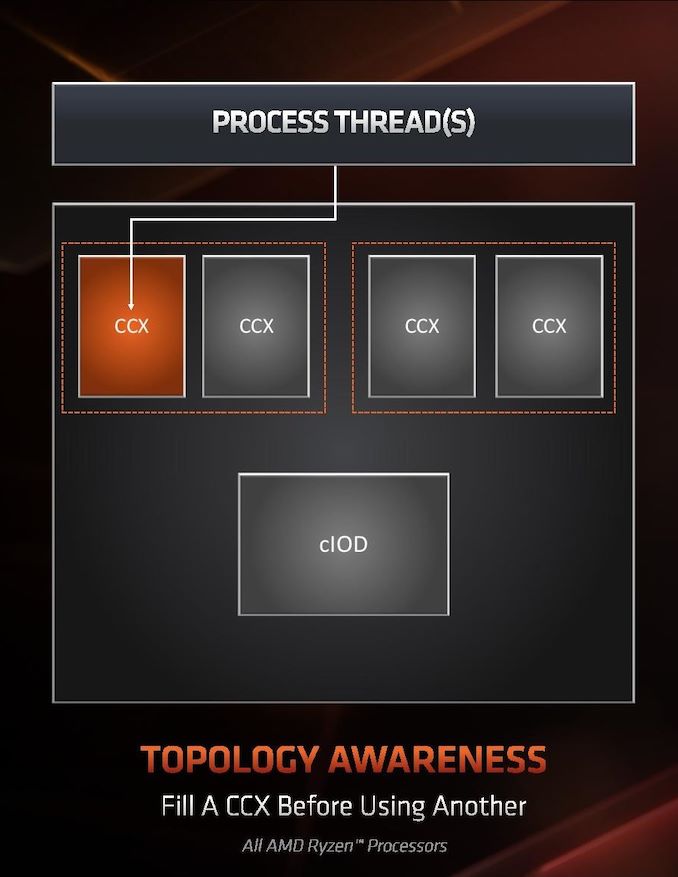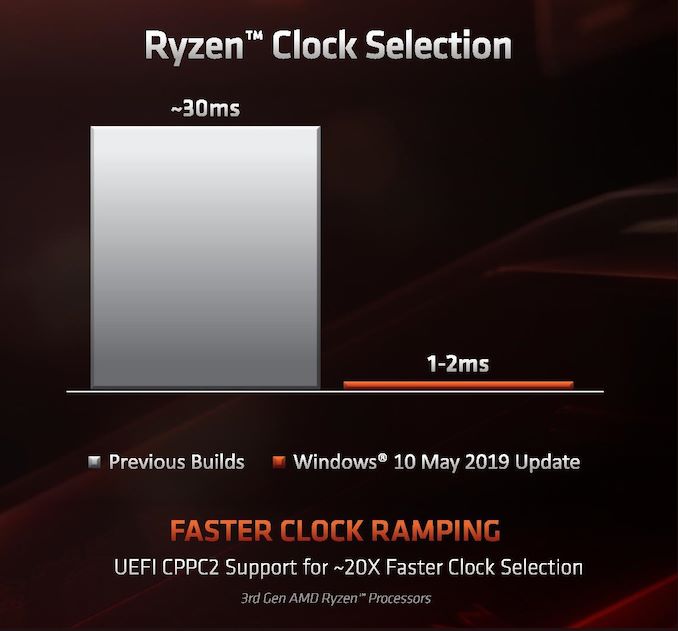The AMD 3rd Gen Ryzen Deep Dive Review: 3700X and 3900X Raising The Bar
by Andrei Frumusanu & Gavin Bonshor on July 7, 2019 9:00 AM ESTSection by Dr. Ian Cutress (Orignal article)
Windows Optimizations
One of the key points that have been a pain in the side of non-Intel processors using Windows has been the optimizations and scheduler arrangements in the operating system. We’ve seen in the past how Windows has not been kind to non-Intel microarchitecture layouts, such as AMD’s previous module design in Bulldozer, the Qualcomm hybrid CPU strategy with Windows on Snapdragon, and more recently with multi-die arrangements on Threadripper that introduce different memory latency domains into consumer computing.
Obviously AMD has a close relationship with Microsoft when it comes down to identifying a non-regular core topology with a processor, and the two companies work towards ensuring that thread and memory assignments, absent of program driven direction, attempt to make the most out of the system. With the May 10th update to Windows, some additional features have been put in place to get the most out of the upcoming Zen 2 microarchitecture and Ryzen 3000 silicon layouts.
The optimizations come on two fronts, both of which are reasonably easy to explain.
Thread Grouping
The first is thread allocation. When a processor has different ‘groups’ of CPU cores, there are different ways in which threads are allocated, all of which have pros and cons. The two extremes for thread allocation come down to thread grouping and thread expansion.
Thread grouping is where as new threads are spawned, they will be allocated onto cores directly next to cores that already have threads. This keeps the threads close together, for thread-to-thread communication, however it can create regions of high power density, especially when there are many cores on the processor but only a couple are active.
Thread expansion is where cores are placed as far away from each other as possible. In AMD’s case, this would mean a second thread spawning on a different chiplet, or a different core complex/CCX, as far away as possible. This allows the CPU to maintain high performance by not having regions of high power density, typically providing the best turbo performance across multiple threads.
The danger of thread expansion is when a program spawns two threads that end up on different sides of the CPU. In Threadripper, this could even mean that the second thread was on a part of the CPU that had a long memory latency, causing an imbalance in the potential performance between the two threads, even though the cores those threads were on would have been at the higher turbo frequency.
Because of how modern software, and in particular video games, are now spawning multiple threads rather than relying on a single thread, and those threads need to talk to each other, AMD is moving from a hybrid thread expansion technique to a thread grouping technique. This means that one CCX will fill up with threads before another CCX is even accessed. AMD believes that despite the potential for high power density within a chiplet, while the other might be inactive, is still worth it for overall performance.
For Matisse, this should afford a nice improvement for limited thread scenarios, and on the face of the technology, gaming. It will be interesting to see how much of an affect this has on the upcoming EPYC Rome CPUs or future Threadripper designs. The single benchmark AMD provided in its explanation was Rocket League at 1080p Low, which reported a +15% frame rate gain.
Clock Ramping
For any of our users familiar with our Skylake microarchitecture deep dive, you may remember that Intel introduced a new feature called Speed Shift that enabled the processor to adjust between different P-states more freely, as well as ramping from idle to load very quickly – from 100 ms to 40ms in the first version in Skylake, then down to 15 ms with Kaby Lake. It did this by handing P-state control back from the OS to the processor, which reacted based on instruction throughput and request. With Zen 2, AMD is now enabling the same feature.
AMD already has sufficiently more granularity in its frequency adjustments over Intel, allowing for 25 MHz differences rather than 100 MHz differences, however enabling a faster ramp-to-load frequency jump is going to help AMD when it comes to very burst-driven workloads, such as WebXPRT (Intel’s favorite for this sort of demonstration). According to AMD, the way that this has been implemented with Zen 2 will require BIOS updates as well as moving to the Windows May 10th update, but it will reduce frequency ramping from ~30 milliseconds on Zen to ~1-2 milliseconds on Zen 2. It should be noted that this is much faster than the numbers Intel tends to provide.
The technical name for AMD’s implementation involves CPPC2, or Collaborative Power Performance Control 2, and AMD’s metrics state that this can increase burst workloads and also application loading. AMD cites a +6% performance gain in application launch times using PCMark10’s app launch sub-test.
Hardened Security for Zen 2
Another aspect to Zen 2 is AMD’s approach to heightened security requirements of modern processors. As has been reported, a good number of the recent array of side channel exploits do not affect AMD processors, primarily because of how AMD manages its TLB buffers that have always required additional security checks before most of this became an issue. Nonetheless, for the issues to which AMD is vulnerable, it has implemented a full hardware-based security platform for them.
The change here comes for the Speculative Store Bypass, known as Spectre v4, which AMD now has additional hardware to work in conjunction with the OS or virtual memory managers such as hypervisors in order to control. AMD doesn’t expect any performance change from these updates. Newer issues such as Foreshadow and Zombieload do not affect AMD processors.














447 Comments
View All Comments
Maxiking - Tuesday, July 23, 2019 - link
LOOOOOOL, so we have a guy confirming AMD doing fraund by misleading people about the frequency, instead of acknowledging the fraund, we gonna talk about semantics.Yeah, if you get sentenced for a sexual assault, you should sue then anyone who has accussed you of raping. Just wow.
Brilliant logic, sir.
Maxiking - Tuesday, July 23, 2019 - link
*fraudQasar - Tuesday, July 23, 2019 - link
still valid there buddy.. like has been said, you are the only one throwing the word fraud around, and that amd should be sued over this. so what everMaxiking - Tuesday, July 23, 2019 - link
And again... let me copy paste."You are uneducated, TDP doesn't mean power consumption or the highest peak but the amount of heat dissipated, it informs you how much of heat the cooler must be able to dissipate in order to keep the cpu cool enough to run.
Get it? 1700x TDP was 95W yet there were tasks it managed to consume 120 or even 140w on stock settings. Like do you even watch reviews? It was the same with 2700x.
but mimimimimimi AMD good mimimimimi Intel bad"
Korguz - Tuesday, July 23, 2019 - link
and yet, you still refuse to admit, that intel has its own issues with fraud and misleading its own customers.does he actually say its fraud ?? not directly, seems only YOU keep saying that, and only YOU say amd should be sued for it. again.., i would love to see YOU file a suit against amd for it, considering you are so hung up about it but you wont, cause you are all talk, no action, and probably know.. you wouldnt get very far with that law suit
Maxiking - Tuesday, July 23, 2019 - link
I said a few times... I don't tend to buy amd products so no, I am not gonna sue anybody.And as pointed out in the video, in his German one, he works for a retailer selling prebuilt pcs.. People keep returning pcs with AMD cpus becaue they do not boost to the promised frequency. You there, there are something like laws, if you write on the box 4.6ghz, it must reach it.
You are so knowledgeable, sharp minded and analytical when comes to meaning of words and what people want to say, you should sue Intel on your own, should be easy.
Korguz - Tuesday, July 23, 2019 - link
why not ?? going by how dead set you are about this.. seems like it would be an easy win for you.. ooooohhhh in the german one.. i understand now.. too bad i dont speak german so i cant confirm this... and if some one writes on the box that something uses a certain amount of power.. then it should use it.. not 50 to 100 watts more.. i have a few friends that buy intels cpus.. they see it uses 95 watts of power.. so they get a HSF that can dissipate that much power.. then wonder why their cpu throttles and runs slow when under load... then i point then to the link i just posted,and they are not happy.. and now need to go buy yet another HSF to handle the extra power.You are so knowledgeable, sharp minded and analytical when comes to meaning of words and what people want to say, you should sue Amd on your own, should be easy. again, too bad you wont.. cause you are all talk. have a good day sir..
Maxiking - Thursday, July 25, 2019 - link
Again, you have once again showed your AMD fanboyism.There is written: TDP 95W. I already explained what TDP means. AMD's TDP isn't accurate either.
AMD has 4.6ghz on the box whilst a bing number cpus does not REACH IT AT ALL. There is no "*" moniker next the 4.6ghz claim and they do not say that their cpu may not reach the frequency at all. In fact, there is a video from AMD on youtube promised even higher frequency, lol. Up to 4.75 ghz.
So yeah, stop being desperate and forcing Intel into the debate.
Because your childish attempts are futile, this is not about AMD or Intel. It is about us consumers. What will be next? 6 Ghz on the box?
Maxiking - Thursday, July 25, 2019 - link
AMD has 4.6ghz on the box whlist a big number of cpus do not REACH IT AT ALL under any load, conditions. Typing on phone is just cancer.Korguz - Thursday, July 25, 2019 - link
and again, like in another thread, you showed how much you hate amd, and are biased against them, and you call me an amd fanboy, you are just as much an intel fanboy. FYI, IF you actually READ the link i posted, you would see that intels 95 watts, is pretty much a MINIMUM their chips use, in reality, its more like 50 to 100 ABOVE that, and also.. amd is A LOT closer then intel is to the TDP they state, but again.. to be fair, amd AND intel use and come do different values for TDP, but you cant see passed your hated for amd to see this.. you are the one that has to resort to name calling, so WHO is being childish ?? what wil be next, intel claiming their cpus use 100 watts, but in reality, they use 300 ?